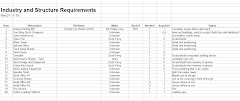 As you can see from the map there are two high volume "industries" which are the Tybee Warf and the Southern/Louisville & Nashville Interchange. Another busy "industry" is the Cotton Team Track. What I like about interchanges, warves and team tracks is that there is virtually no limit to their cargo type. They can ship and recieve most anything.
As you can see from the map there are two high volume "industries" which are the Tybee Warf and the Southern/Louisville & Nashville Interchange. Another busy "industry" is the Cotton Team Track. What I like about interchanges, warves and team tracks is that there is virtually no limit to their cargo type. They can ship and recieve most anything. In this case the Cotton Team Track is the farmer's supply line. Farm Machinery, seed, feed and supplies can all arrive by LCL (Less than Car Load) from the warf or the interchange. Likewise, every business needs parts and supplies, so the warf and interchange can provide traffic to everyone.
The main "business" of the railroad is moving cotton. While the business chain of cotton is present:
There is an abundance of alternate routes as well. Raw cotton can go to the warf directly, or the interchange. The Gin can ship straight out to these locations as well, by passing the Mill which might not be paying top dollar today.
This highly integrated supply chain model allows for traffic to move in and among all the players on the layout making for an interesting operating model.
What is the Southern Railway Supply Office? Why the have a business in keeping the train running. This business needs coal, sand lubricants, repair parts and supplies. It becomes an industry as well. It even ships an empty sand gondola back to the river sand company.
Next, we have to figure out how many rail cars we need and of what type. That takes a different kind of chart.








No comments:
Post a Comment